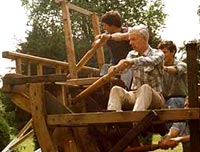
John Coates, front, demonstrating the three-level system of the trireme with oarsmen from Cambridge University
John Coates, who died on July 10 aged 88, had retired as chief naval architect at the Ministry of Defence when he took a central role in the building of a Greek trireme, the first, fastest and best known oared warship of the ancient world.
Triremes were 100ft three-tiered vessels powered by two square sails and a huge crew of oarsmen. They were used at the Battle of Salamis in 480BC when the Greeks defeated the Persians (who were led by the emperor Xerxes), and there are references to them in classical literature and depictions on pottery relics and coins.
Tipped with a deadly bronze ram to sink enemy ships, the trireme struck Coates as the ancient equivalent of a guided missile. Contrary to the Hollywood notion of these vessels being manned by convicts or galley slaves languishing beneath a brutal lash, triremes were known to have been rowed by volunteers who brought their own oars and seat cushions.
But exactly how the vessels were rowed, and the configuration of the oarsmen, remained one of the oldest controversies in classical scholarship.
In 1982 Coates was approached by Professor John Morrison, the recently-retired president of Wolfson College, Cambridge, who believed that the trireme had been rowed by 170 oarsmen deployed on three levels, one above the other, a hypothesis that had provoked a marathon correspondence in The Timesin 1975.
When the author and businessman Frank Welsh suggested that Morrison should try a full-scale reconstruction to demonstrate the practicability of his three-tiered oar system, Coates joined Morrison and Welsh in setting up the Trireme Trust. Coates’s challenge was to design a viable ship which would be true both to the ancient evidence and the laws of physics.
Under Coates’s expert direction, the trust built first a mock-up of a trireme and then a floating trial piece with 12 oars, which was displayed at Henley Royal Regatta in 1985. They then persuaded the Greek Ministry of Culture and the country’s navy to fund and build a full-scale replica in Greece. Named Olympias, the trireme – constructed of Oregon pine and 25,000 bronze nails – was launched in June 1987 and commissioned into the Hellenic Navy.
She was rowed and displayed around the Aegean, and between 1987 and 1994 underwent five series of sea-trials at Poros with volunteer international crews; in 1993 she also visited the Thames in London as part of the celebrations of 2,500 years of Greek democracy.
Despite her colossal size (she weighed 22 tons fully laden), Olympias could make 8.9 knots at 46 strokes a minute. Coates found that getting 170 oarsmen on and off the ship in orderly fashion took between 10 and 15 minutes, but could be accomplished at the double in a minute and a half, with a total emergency evacuation over the side in a mere 24 seconds.
Thanks to Alaric Bond for pointing out the obituary.

Pingback: Trireme Olympias Stricken from London Olympics – Fears of Popularity and Bridge Jumpers | Old Salt Blog – a virtual port of call for all those who love the sea